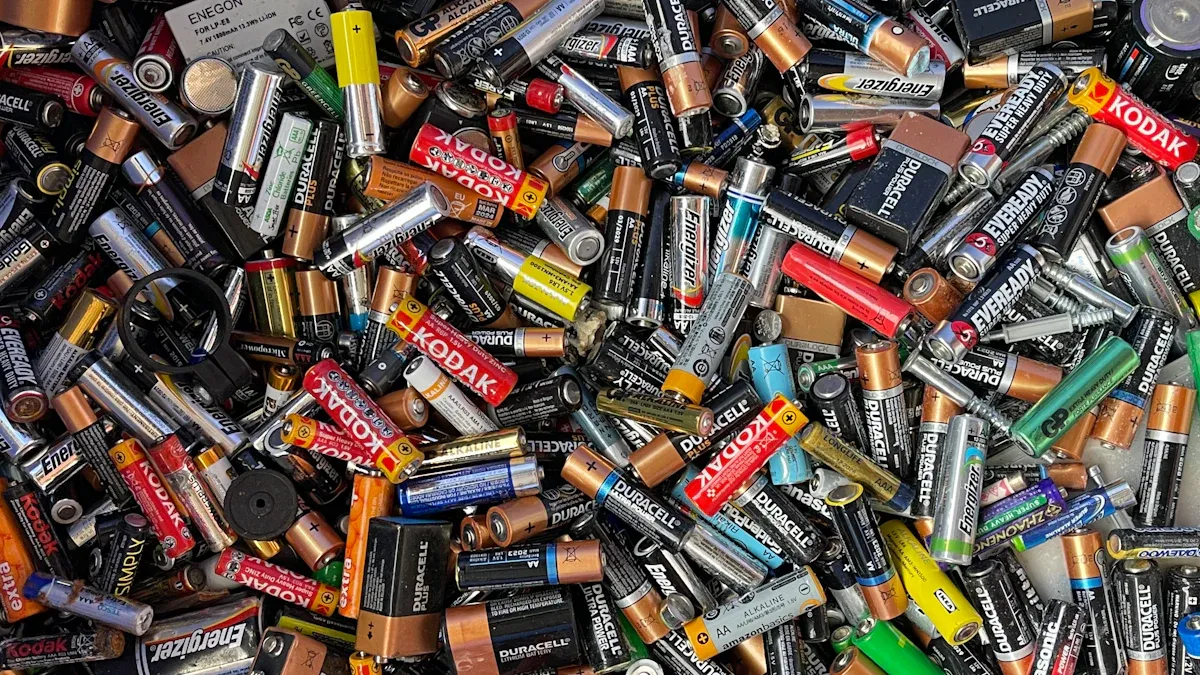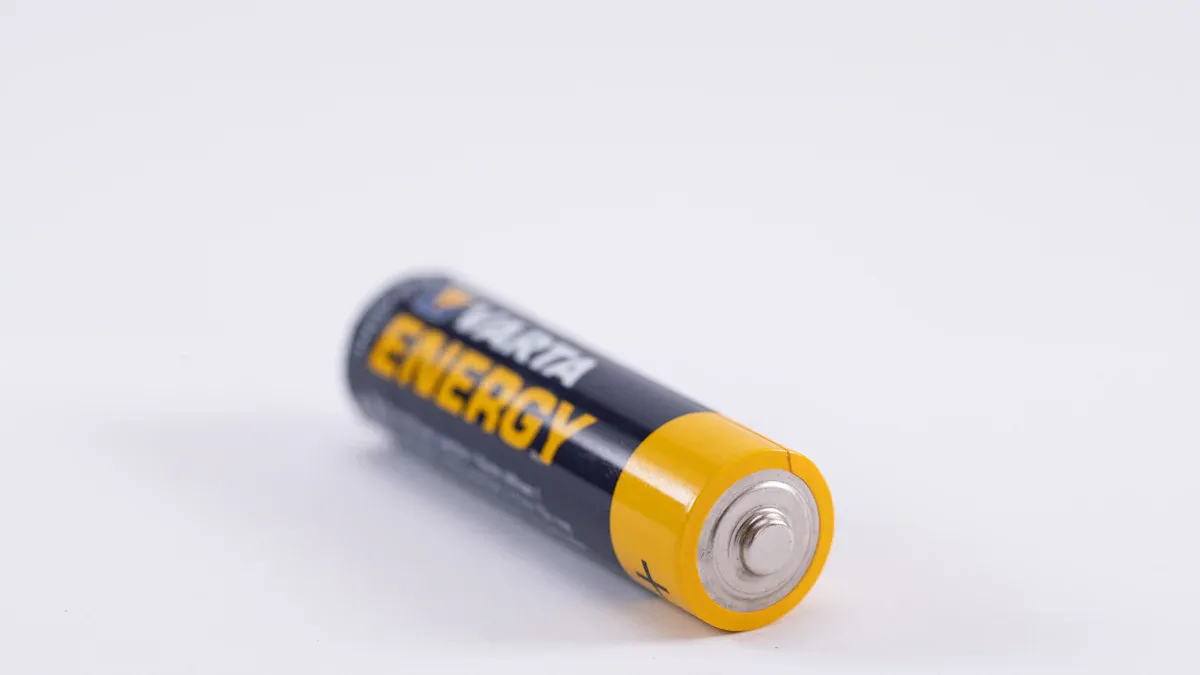
I observe the global alkaline battery market was valued between USD 7.69 billion and USD 8.9 billion in 2024. Experts project significant growth. We anticipate Compound Annual Growth Rates (CAGRs) ranging from 3.62% to 5.5% through 2035. This indicates a robust future for alkaline battery technology.
Key Takeaways
- Alkaline batteries are very popular. They power many everyday items like remote controls and flashlights. They are cheap and easy to find.
- The market for alkaline batteries is growing. This is because more people use electronics. Also, countries in Asia are buying more of them.
- New types of batteries are a challenge. Rechargeable batteries last longer. But alkaline batteries are still good for many devices.
Current Global Market Status of Alkaline Batteries

Market Size and Valuation of Alkaline Batteries
I observe several critical factors influencing the valuation of the alkaline battery market. Raw material costs, for instance, play a significant role. The prices for essential materials like zinc and electrolytic manganese dioxide directly impact manufacturing expenses. I also consider the manufacturing processes themselves. Automation, technology, and labor costs all contribute. Advanced machinery and efficient production techniques can reduce costs, while rigorous quality control measures ensure reliability.
Market dynamics also shape the market’s value. I see how supply and demand, consumer trends, and brand positioning affect pricing strategies. Logistics and transportation costs, influenced by fuel prices, add to the final retail price. Environmental regulations, while increasing production costs due to requirements for eco-friendlier materials, also promote sustainable practices. I also note the impact of product substitutes. Competition from rechargeable batteries, like NiMH and Li-ion, poses a threat, especially where frequent recharging is feasible. Technological advancements, such as improved energy density, influence market competitiveness. Consumer preferences and global economic expansion further affect overall market growth.
Key Players in the Alkaline Battery Market
I recognize several key players dominate the global alkaline battery market. My analysis points to Duracell, Energizer, Panasonic, Toshiba, and VARTA as leading manufacturers. Duracell and Energizer, in particular, hold significant market shares. Their products are available in over 140 and 160 countries, respectively, demonstrating their extensive global reach. Panasonic also maintains a strong presence, especially across Asia and Europe. I see Rayovac focusing on affordability, making it popular in cost-conscious regions. Other manufacturers, like Camelion Batterien GmbH and Nanfu Battery Company, cater to specific markets such as Europe and China.
I also want to highlight companies like Ningbo Johnson New Eletek Co., Ltd. They stand as a professional manufacturer of various kinds of batteries, including alkaline batteries. I note their substantial assets, including 20 million USD and a 20,000-square-meter manufacturing floor. Over 150 highly skilled employees work on 10 automatic production lines, adhering to ISO9001 quality systems and BSCI standards. Their commitment extends to environmental protection; their products are free from Mercury and Cadmium, meeting EU/ROHS/REACH Directives and SGS certification. I find they supply quality products at competitive costs, offering professional sales support and competitive battery solutions globally. They also welcome private label services. Choosing Johnson Electronics means choosing reasonable cost and considerate service.
Driving Forces for Alkaline Battery Market Growth
Sustained Demand in Consumer Electronics for Alkaline Batteries
I observe a significant driver for the alkaline battery market comes from the sustained demand in consumer electronics. The rapid growth of these devices, fueled by technological advancements and changing lifestyles, directly boosts battery consumption. I see that consumer electronics are projected to account for 53.70% of the total share in the alkaline battery market in 2025, making them the dominant application segment. Many everyday items rely on these power sources.
- General Consumer Electronics: Remote controls, digital cameras, flashlights, gaming controllers.
- Smaller Electronic Devices (AAA batteries): Remote controls, digital thermometers, small flashlights.
- Higher Power/Longer Operation Devices (C and D batteries): Larger flashlights, portable radios.
- Higher Voltage Applications (9V batteries): Smoke detectors, certain walkie-talkies, medical devices.
The convenience, reliability, and extensive shelf life of alkaline batteries make them a preferred choice for these applications.
Affordability and Widespread Accessibility of Alkaline Batteries
I find that the affordability and widespread accessibility of alkaline batteries significantly contribute to their market growth. Rechargeable batteries are initially more expensive, offering long-term savings with repeated use. In contrast, alkaline batteries provide convenience and affordability, making them more suitable for low-drain or seldom-used devices. Their distribution network is extensive, ensuring easy access for consumers globally.
- Online Stores: Offer convenience, competitive pricing, and a wide product range, driven by e-commerce growth and internet penetration.
- Supermarkets and Hypermarkets: Provide a one-stop shopping experience, wide availability, and attractive pricing in both urban and rural areas.
- Specialty Stores: Cater to specific needs with curated selections and personalized service for specialized applications.
- Other Channels: Include convenience stores for on-the-go purchases, hardware stores for DIY enthusiasts, and wholesale distributors.
Global logistics networks and strategic partnerships further expand product reach, especially in emerging markets.
Growth in Emerging Economies Boosting Alkaline Battery Consumption
I see emerging economies playing a pivotal role in expanding the alkaline battery market. Regions in Asia, Latin America, and Africa are undergoing rapid industrialization and urbanization. This leads to increased consumer spending and a greater demand for electronic devices. The affordability and accessibility of alkaline batteries make them a preferred choice for powering everyday gadgets. The growing middle class in these economies further boosts demand for reliable power sources. Asia Pacific is projected to be the fastest-growing region, driven by a rising population and increased spending on personal electronic devices. Nations like India and China lead in consumption due to their growing middle-class population and rising disposable incomes. In Latin America, countries such as Brazil and Mexico experience a surge in use for both household and industrial applications.
Challenges Facing the Alkaline Battery Market
Competition from Rechargeable Battery Technologies
I observe a significant challenge for the alkaline battery market comes from the growing competition with rechargeable battery technologies. Rechargeable options, including lithium-ion and nickel-metal hydride, have seen remarkable advancements in energy density and charge cycles. I find these batteries offer superior performance, especially for power-hungry gadgets, by maintaining a steady voltage output. While their initial cost is higher, they prove more cost-effective over time due to their reusability. This reusability also aligns with a global emphasis on reducing electronic waste, making them an attractive choice for environmentally conscious consumers. Major electronics manufacturers are increasingly integrating built-in rechargeable packs, further eroding the market share traditionally held by alkaline batteries.
Environmental Concerns and Regulatory Pressures on Alkaline Batteries
I recognize environmental concerns and regulatory pressures also pose a challenge for alkaline batteries. Although not all are classified as hazardous waste, their single-use nature contributes significantly to waste generation. I understand their production requires energy-intensive mining of zinc, manganese, and steel, impacting the environment. The EPA classifies certain alkaline batteries as hazardous due to toxic materials, requiring specific management for storage and labeling. While technically recyclable, the process is complex and costly, leading to low recycling rates. I see various states, like California and New York, implementing producer responsibility laws, which add to manufacturing costs and operational complexities.
Supply Chain Volatility Impacting Alkaline Battery Production
I find supply chain volatility significantly impacts alkaline battery production. The prices of essential raw materials, such as potassium hydroxide and manganese dioxide, can fluctuate. For instance, manganese dioxide prices have seen declines due to shifts in global demand, while potassium hydroxide prices have shown moderate fluctuations. Zinc prices, however, have remained relatively stable. I observe that broader supply chain challenges, including transportation delays or shortages in mining outputs, can lead to price increases. Geopolitical factors and environmental policies in mining regions also introduce instability, potentially disrupting supply and increasing production costs for manufacturers.
Regional Dynamics of the Alkaline Battery Market
North American Alkaline Battery Market Trends
I observe North America shows distinct trends in alkaline battery consumption. Primary alkaline batteries remain the dominant product type. Consumers widely use them in household electronics and portable devices. I see consumer electronics, including remote controls, toys, and flashlights, represent the largest application segment. There is a growing trend towards eco-friendly and recyclable options. This reflects increasing environmental consciousness and regulatory frameworks. Rechargeable alkaline batteries are also gaining popularity. This is due to environmental concerns and long-term cost-effectiveness. I note the expansion of distribution channels, with online marketplaces and subscription services gaining traction. Smart technologies in battery-powered devices push for longer-lasting and more reliable power sources. I also see growing demand from emerging applications like smart home devices and portable medical equipment.
European Alkaline Battery Market Overview
I find the European market for alkaline batteries is significantly shaped by comprehensive regulations. The European Battery Regulation (EU) 2023/1542, effective since February 18, 2024, applies to all new batteries introduced to the EU market. This regulation covers all battery types, including portable batteries like alkaline batteries. It introduces new requirements for manufacturers, phased in over time. These focus on environmental sustainability, material safety, and specific labeling. The regulation also addresses end-of-life management and manufacturer due diligence. It even includes a digital battery passport for traceability. This new regulation replaces the 2006 EU Batteries Directive. It aims to reduce the environmental impact of batteries throughout their entire life cycle.
Asia-Pacific Dominance in Alkaline Battery Consumption
I see the Asia-Pacific region as the leading market in the global alkaline battery sector. It experiences the fastest growth due to several factors. These include a growing population with increasing disposable income and a rising demand for consumer electronics. Rapid economic development and an expanding middle class also contribute. Key contributors like China, Japan, India, and South Korea are significant. Their large populations, robust economies, and quick adoption of technology collectively drive the region’s strong position. Rapid industrialization, significant infrastructure development, and substantial foreign investments further fuel this growth. An expanding middle-class population and considerable investments in high-potential markets such as China, India, and Southeast Asia also contribute to its leading position.
Latin America and MEA Alkaline Battery Market Potential
I recognize Latin America and the Middle East & Africa (MEA) regions hold significant potential for the alkaline battery market. These regions are experiencing economic growth and increasing urbanization. This leads to a rise in disposable incomes and greater access to consumer electronics. The affordability and widespread availability of alkaline batteries make them a practical choice for many consumers. I anticipate continued growth as infrastructure develops and consumer demand for portable devices expands.
Primary Applications of Alkaline Batteries

I find alkaline batteries power a vast array of devices across various sectors. Their reliability, affordability, and long shelf life make them a preferred choice for many applications. I will explore some of their primary uses.
Alkaline Batteries in Household Devices and Appliances
I find alkaline batteries indispensable for countless household items. They power many devices we use daily. I see them in remote controls, wall clocks, and alarm clocks. Wireless keyboards and mice also frequently rely on them. Battery-powered toys and gadgets often need them too. Smoke detectors and CO alarms use them for critical safety. Flashlights and emergency kits are another common application. Portable radios and weather receivers also depend on them. Digital thermometers and medical devices often require them. Wireless doorbells and camping headlamps and lanterns complete the list of common uses. I believe their reliability makes them a preferred choice for these essential items.
Use of Alkaline Batteries in Remote Controls and Toys
I observe alkaline batteries are particularly prevalent in remote controls and toys. These devices often require a consistent, low-drain power source. Remote controls for televisions, media players, and smart home devices typically use AAA or AA sizes. Toys, from simple action figures with sound effects to more complex remote-controlled vehicles, also depend on them. I find parents appreciate the convenience and long shelf life of alkaline batteries for children’s toys. This ensures uninterrupted playtime.
Portable Lighting and Flashlights Powered by Alkaline Batteries
I see alkaline batteries as the backbone of portable lighting solutions. Flashlights, from small pocket-sized models to larger, heavy-duty versions, almost universally use them. Emergency kits often contain alkaline-powered flashlights. Camping headlamps and lanterns also rely on them for illumination in outdoor settings. I value their dependable performance in situations where a power outlet is unavailable.
Alkaline Batteries in Medical Devices and Health Monitors
I recognize the critical role alkaline batteries play in medical devices and health monitors. These devices demand reliable power for accurate readings and consistent operation. I know glucose meters and thermometers frequently use them. Many other portable health monitors, such as blood pressure cuffs and pulse oximeters, also depend on their stable power output. I understand the importance of dependable power in these sensitive applications.
Security Systems and Smoke Detectors Utilizing Alkaline Batteries
I find alkaline batteries essential for maintaining safety and security in homes and businesses. Smoke detectors and carbon monoxide alarms, for instance, rely on them as a primary or backup power source. This ensures they remain operational during power outages. Wireless security sensors and motion detectors also frequently use alkaline batteries. I believe their long shelf life is crucial for these devices, which often operate unattended for extended periods.
Defense-Grade Equipment Relying on Alkaline Batteries
I observe alkaline batteries also serve in more specialized, defense-grade equipment. While high-performance military applications often use lithium-ion, certain robust and reliable defense devices still incorporate alkaline batteries. These might include specific communication devices, specialized lighting, or backup power for less critical systems in the field. I understand their widespread availability and cost-effectiveness can make them a practical choice for certain non-rechargeable military applications.
Future Outlook and Innovations in Alkaline Batteries
I see a dynamic future for alkaline batteries, marked by continuous innovation and a strong push towards sustainability. Manufacturers are not only refining existing technologies but also exploring new applications and environmentally conscious production methods.
Incremental Performance Improvements in Alkaline Batteries
I observe significant efforts to enhance the performance of alkaline batteries. Researchers are utilizing high-performance zinc anodes to boost energy output and extend battery lifespan. They are also exploring eco-friendly electrolytes to maintain or improve battery performance while reducing environmental impact. Recent advancements, particularly by 2025, have focused on enhancing battery performance. I find manufacturers are prioritizing improvements in energy density and discharge rates, which directly contribute to extending battery life. These innovations ensure alkaline batteries remain reliable and meet modern device demands.
Sustainable Manufacturing Practices for Alkaline Batteries
I believe sustainability is becoming a priority for alkaline battery manufacturers. They are adopting eco-friendly practices and developing recyclable batteries. Some manufacturers now produce eco-friendly alkaline batteries using sustainable materials and cleaner production methods. I also see brands offering recyclable options, aligning with the growing demand for environmentally responsible products. There is an increased focus on sustainability, compelling manufacturers to adopt more sustainable manufacturing practices and utilize environmentally friendly materials. Recycling initiatives are also gaining prominence. I notice manufacturers are exploring more sustainable and user-friendly packaging solutions to enhance product appeal and reduce environmental impact, often switching to recycled materials and simplifying designs.
Niche Market Expansion for Alkaline Batteries
I anticipate alkaline batteries will continue to find new applications in niche markets. Their reliability and cost-effectiveness make them suitable for specialized devices where consistent, long-term power is essential. I expect to see them in more smart home sensors, remote monitoring systems, and certain portable medical devices that do not require high-drain power.
I find the alkaline battery maintains its enduring relevance. Its affordability, reliability, long shelf life, and unmatched global availability are crucial. I project continued market growth. Diverse applications and ongoing innovation will drive this expansion. This ensures its vital role in powering our world.
FAQ
What makes alkaline batteries a popular choice for household devices?
I find their affordability, reliability, and long shelf life make them ideal. They provide consistent power for many everyday items, from remote controls to smoke detectors.
Can I recycle alkaline batteries?
I understand recycling alkaline batteries is possible, though complex. Many communities offer collection programs. Companies like Ningbo Johnson New Eletek Co., Ltd. also ensure their products meet environmental directives.
How do alkaline batteries compare to rechargeable options?
I see alkaline batteries offer immediate convenience and lower initial cost. Rechargeable batteries, while more expensive initially, provide long-term savings and reduce waste through repeated use.
Post time: Oct-15-2025




